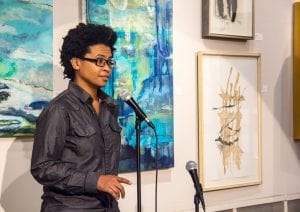
The Art of Courageous Conversation —
Is One Needed Now More Than Ever?
By JULIE GARISTO, May 11, 2018
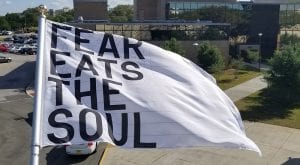
In today’s challenging times — in light of recent news of severe budget cuts to the arts and other quality-of-life-enhancing programs — is a courageous conversation about inequalities and injustices needed more than ever now in Tampa Bay arts venues?
First, what exactly is this buzz-term “courageous conversation”? According to The Jewish Chronicle, “courageous conversations take place in a period of sustained uncertainty, wherein the most challenging and important topics are discussed forthrightly. … When reality gives way to a new normal, one cannot afford to shy away from talking about matters of ultimate import and significance.”
Through courageous conversation, thought leaders are vying to influence hearts and minds on matters related to race relations and other forms of discrimination — arguably a much needed chat as we’re continually inundated with news of African-Americans dying at the hand of police officers, the outcry of #metoo victims, disenfranchised DREAMers, African and Middle Eastern immigrants drowning at sea and too many other human rights violations.
Arts stakeholders are among those heeding the call for meaningful and challenging dialogue. More and more gallery and museum owners, curators, theater and nonprofit directors and others are inviting ideas dialogue on topics affecting 21st-century society.
Conversation starters
Last year in St. Petersburg, Maureen McDole, director of the nonprofit Keep St. Pete Lit, partnered with the League of Women Voters of the St. Petersburg Area to invite women writers to compose essays, poems and fiction inspired by passages of The Handmaid’s Tale. The evening titled “Handmaids Respond: A Literary Speakout” offered candid viewpoints from scribes of all ages. Margaret Atwood’s dystopian novel inspired confessional, cathartic and humorous works touching on suppression, abuse, subjugation and other situations involving the inequalities experienced by women.
Last month KSPL coordinated the SunLit Festival. Among its events throughout April, Life on the Deuces: An Intersection of History and Home. For the April 21st event, Kitchen Table Literary Arts partnered with Cultured Books and the Dr. Carter G. Woodson African American History Museum to explore the history of The Deuces district in South St. Petersburg. Participants will learn about the legacy of the neighborhood, “which is steeped in stories of resilience and community amid the racial redlining and disenfranchisement at the core of the city’s lingering segregation.”

Throughout the year, The Dr. Carter G. Woodson African American Museum provides a haven for art, education, local history and discussion.
“It’s imperative to invite diverse populations to participate and create a space that all feel welcome,” adds McDole. “This not only brings in a wide variety of perspectives but also creates a more dynamic event for audiences. We are doing our best in this area, but there’s always more work to do. Being conscious in your programming and content creation is essential to create a dynamic experience for all involved. We hope that we create a safe shared space for people to bring all their thoughts and ideas to the table. Building from this intention is what creates an open-minded and inspiring creative community. The arts provide the ideal vehicle for this type of rich community experience.”
Sometimes a courageous conversation can take place in a museum that has art one doesn’t immediately associate with social issues, but the works on display can tell a dynamic range of stories. For instance, the collection in the new James Museum of Western and Wildlife Art. The expansive museum features a surprisingly diverse group of artists and a range of perspectives.

“The museum’s Native Artists Gallery is dedicated to paintings and sculptures by 20th- and 21st-century Native artists, including Hopi, Navajo, Apache, and Sioux,” explains Curator Emily Kapes. “Each tribe has their own unique culture which influences the artists, and the museum is honored to be a platform for their work and messages. There are also several paintings by current Chinese American artists that speak to the experiences of 19th-century Chinese immigrants to California. It might be a surprising subject for a Western art museum, but the Chinese played an important role in settling the West.”
There is a great opportunity for dialogue and education about these topics, Kapes adds. “Often schools don’t get detailed with the histories of these peoples. Conversations about our country’s 19th-century racial and cultural tragedies are important to remind us of our country’s past, how far we’ve come, and yet how far we have to go.”
One of the many works in the collection that serves as a conversation starter on animal rights and species protection, Dark Day on the Plains by David Yorke (2010) hangs in the Frontier Gallery of the museum. The breathtakingly upsetting work shows a bison hunt by train.
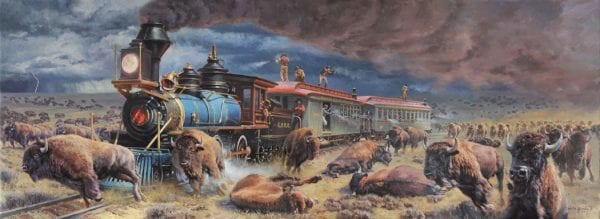
“The widespread slaughter of bison was sanctioned by the U.S. government as a way to take over land occupied by Native Americans,” Kapes explains. “Railroads that crossed the Great Plains promoted ‘hunting by rail’ for sport, and the U.S. Army even provided free ammunition for these ‘safaris.’ This concerted effort resulted in the decimation of the Indians’ bison-based economy and culture. North America was once home to millions of bison, but they were nearly driven to extinction by the late 1880s.”
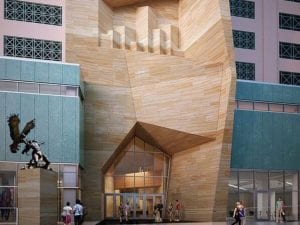
Privately owned galleries sometimes take risks with challenging topics in their exhibitions. Leslie Curran Gallery, a showplace for top artists in all media, doesn’t shy away from topical subjects. Many of their exhibited artists, such as mixed-media sculptor Frank Strunk III, featured in March, have displayed works that involve an investigation into how we live and deal with one another.
“I think it’s important to offer that opportunity,” owner Leslie Curran says. “We need to have spaces in the community where people can openly discuss important matters — whether locally or nationally focused. … It doesn’t mean you agree with everyone or that the people who come view a show should agree with the paintings or installations. It means there’s an opportunity for frank discussion.”
Curran added that she’s excited to be showing videos and photographs by Robin Perry Dana, her gallery director and curator for the majority of the gallery’s shows, as well as the textiles and paintings of Jeannine Hascall. The show, Nouvelle Vague (New Wave), juxtaposes the complementary sensibilities of two women of different generations, inspiring some thought on gender issues today.
Issue-driven public art installations have been widespread around the world in major cities but slow to spring up in Tampa Bay — but that too has changed thanks to the University of South Florida’s Institute for Research in Art, which received an invitation to participate in a nationwide public art project.
Since July 2017, the University of South Florida Contemporary Art Museum has participated in Pledges of Allegiance, coordinated by the nonprofit Creative Time. The collaborative event series enlists 16 acclaimed artists and 20 organizations across the nation and mounts a different artist-designed flag roughly every four weeks. Each banner points to an issue the artist is passionate about.
The exhibition has succeeded in initiating dialogue. Locally, public conversations have taken place on a monthly basis during Pledges of Allegiance, at events commemorating the flag-raisings and online. So, not only have the events around the exhibition spurred conversation, but the project has also promoted constructive civil discourse — a welcome contrast to the trolling and finger-pointing that have become too prevalent on comment boards.
“The social media component builds a momentum and creates a collective shared experience,” USF Curator Sarah Howard affirms.
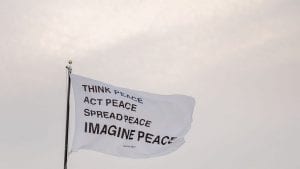
Participating artists in the Pledges of Allegiance project include Tania Bruguera, Alex Da Corte, Jeremy Deller, LaToya Ruby Frazier, Ann Hamilton, Robert Longo, Josephine Meckseper, Marilyn Minter, Vik Muniz, Jayson Musson, Ahmet Ögüt, Yoko Ono, Trevor Paglen, Pedro Reyes, Rirkrit Tiravanija, and Nari Ward. See them all Aug. 3-Sept. 4, when USFCAM will present all of the artist flags in Raise the Flag: Pledges of Allegiance. Should be stunning visually — Howard says that the museum will assemble the entire Pledges of Allegiance flag series on the exterior façade of the museum.
USF mounted Tiravanija’s flag with the message “Fear Eats the Soul” on April 4, the 50th anniversary of Dr. Martin Luther King Jr.’s death. Howard, Curator of Public Art and Social Practice, has helped spearhead public events in tandem with the flag-raisings to get community input. During the MLK anniversary event, CAM hosted a reading from Dr. Luther King’s Antidotes For Fear.
It was quite a boon for the university-run museum to be chosen by Creative Time, which works from three core values: art matters, artists’ voices are important in shaping society, and public spaces are places for creative and free expression. Other projects they’ve commissioned include Tribute in Light, the twin light beams emanating from the roof of the Battery Parking Garage south of the 9/11 Memorial, bus ads promoting HIV awareness and Paul Chan’s production of Waiting for Godot in New Orleans.
Could USF/Creative Time’s exhibition inspire an invigorated public art commitment by locals? ”
We’ve been to talking to local cultural organizations about another initiative this fall that will address our civic freedoms,” Howard shared.
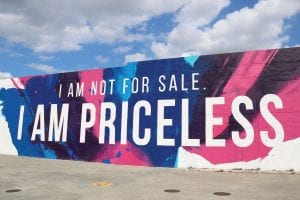
They certainly won’t be the first. Last summer, prominent Tampa artist Tes One, aka Leon Bedore, used the creatively eye-catching medium of mural design to broadcast a message on human trafficking. Before that. Illsol‘s Tony Krol and Michelle Sawyer created a mural to call attention to a historic Tampa Heights looming threats by an Interstate toll-lanes expansion.
Says Krol in his Facebook post: “I included a slide in Murals for Property Owners a Best Practices Discussion that talked about public art being used for activism. “I forgot to include a powerful image: Last summer Leon Bedore Tes One completed this mural that not only brings to light a dark side of Tampa but offers a solution and help directly within the art. Last October, 84 children forced into sex trafficking were recovered by the FBI here in Tampa. Our beautiful city in the sun isn’t without its issues. Art is incredibly powerful, and as we continue to put up imagery on walls, we have an opportunity for impactful messages. You can speak up on any issue through art. Shepard Fairey, Brandan Bmike Odums are a couple great examples of this. Raise the bar, think big.
For those who missed the presentation, Illsol‘s very first mural was a statement to FDOT West Central – Tampa Area, a statement against widening a wound that already exists through the city. Cafe Hey/Oceanic (Asian supermarket) was and still may be on the list of properties to be purchased to widen the interstate for toll lanes with variable pricing that not many in Tampa would not be able to afford to drive on.
“.. Art with purpose; it does exist in our city,” Krol adds, “and it can exist more as businesses engage artists to paint on their buildings. Keep that in mind.”
The Climate Change Conversation
With climate change, a courageous conversation has the potential to be less grim, preachy and threatening than stereotypes suggest. Artists can tap pleasure centers in the brain involved with our sense of beauty, wonder and affection toward wildlife and fauna. It’s not a doom-and-gloom tirade, which one can argue makes the conversation starters even more engaging.
One Florida artist calls attention to climate change science through art in a big way. Miami-based installation artist Xavier Cortada, featured this week in Florida illustrated, an informative lifestyle blog by Tampa Bay freelance writer Jennifer Ring, details major statewide and international projects initiated by Cortada, impressive both aesthetically and in scope. In the feature, “Communicating science through art: Introducing the work of Xavier Cortada, we learn about how Cortada has called attention to the melting of polar ice, which has begun melting at such an accelerated rate that the stake marking the geographical location of the South Pole, where all longitude lines converge, has to be relocated annually. “Cortada used flags,” Ring explains. “He planted 50 flags into the polar ice sheet, with each flag representing the location of the marker in years’ before. They formed a row, half a kilometer long, with each flag about 10 meters away from the next.”
In Florida, Cortada’s project FLOR500 uses art to aid in reforestation.When the state turned 500 years old in 2013, Ring adds. The artist commemorated the quincentenary by initiating a campaign to plant 500 new Florida wildflower gardens across the state. In addition, he invited artists from regions throughout the state to draw each of the flowers. Local participants include Carrie Jadus and Kristen Gilpin.
At the Morean Arts Center, two upcoming exhibitions (May 12-June 23) will call attention to the endangered environment — another undertaking with an emphasis on the joy and wonder we feel while encountering nature. One of the exhibits, “Leslie Neumann: Manna from Heaven … and Earth,” shows the trajectory of an established artist and conservationist‘s work over a long period of time, focusing on the beauty of nature vs. our troubling current events.
“This exhibition does succeed as a kind of protest,” Curator Amanda Cooper says in the brochure for the show. “If you ever thought about land conservation and wondered why it was important or whether you should care about it — one only has to look at these paintings to see what we stand to lose. Sometimes a beautifully and lovingly crafted work of art speaks louder than a megaphone.”

Also featured at the Morean this weekend, “Water Over the Bridge: Contemporary Seascapes,” showcases works reflecting the effects of global warming on oceans, selected by New York-based independent curator D. Dominick Lombardi. The exhibition features the works of artists from both the New York City metro area and Tampa Bay area artists. Participating artists include Selina Roman, Anne Bowen, Babs Reingold, Carolina Cleere, Margaret LeJeune, Rieko Fujinami, Bill Gusky, Dale Leifeste, China Marks and William Thompson.
The show must go on … but how?
Over the past decade, theater houses have steered from done-to-death musicals and farces to more contemporary and challenging fare. Personnel changes at American Stage in St. Petersburg and Stageworks Theatre in Tampa have brought in younger audiences with all manner of topical dramas and comedies.
Since joining American Stage’s staff as producing artistic director in 2015, Stephanie Gularte has branded the theater as a forum for ideas, instituting seasonal themes such as “We the People” — plays that elicit reflection and discourse on living in America today.
But how feasible is provocative content and discussion in the wake of alarmingly drastic state budget cuts recently announced?
According to the Tampa Bay Times, arts funding has grown smaller by the year, from $43 million in 2014 to $35 million in 2015. In 2016, it decreased an additional 30 percent, and this year’s budget cuts drop Florida’s ranking in per capita appropriations from 10th in the country to 48th, according to the National Assembly of State Arts Agencies. The cuts threaten The Florida Orchestra’s mini-concerts in schools and airports and hospitals.
“Sometimes a beautifully and lovingly crafted work of art speaks louder than a megaphone.” –Amanda Cooper
“Those in the arts expected things to be bad, but not this breathtakingly bad,” Times performing arts critic Andrew Meacham wrote in his April 9 story, “As Florida dramatically slashes arts funding, theaters and museums scramble.”
Federal budget cuts are just as drastic. According to The Hill, President Trump’s proposal calls for drastically reducing the funding to begin closing the National Endowment for the Arts, the National Endowment for the Humanities, the Institute of Museum and Library Services and the Corporation for Public Broadcasting. The four agencies would share $109 million in 2019, an overall cut of $917 million.
The rally to cut funding to the arts has gained traction. The conservative think-tank The Heritage Foundation has Google on blast with its “Ten Good Reasons to Eliminate Funding for the National Endowment.’’ You can’t Google the term “funding” and “arts” without finding the listifesto in your search results.
Their rationale is pervasive, intended to delegitimize the urgency and protests of arts supporters. Says Romina Boccia of the Heritage Foundation: “I am even more concerned about federal funding and political intervention leading to mediocrity than I am about potentially controversial art being funded with taxpayer dollars.”
The kicker: Our nation’s most recognized endowment agencies and public television combined counts for only one-tenth of 1 percent of the United States’ annual federal spending, an amount supporters claim to too small to make a difference.
Jobsite Theater in Tampa has earned a loyal flowing and critical plaudits for its edgy, thought-provoking programming. Producing Artistic Director David M. Jenkins says he fully believes arts stakeholders have a responsibility to hold a mirror up to nature, and that means, he explains, addressing things that some may find generally “political,” or that are rooted in “identity politics” or “issues.”
Jobsite’s current production, an adaptation of George Orwell’s 1984, indeed reflects the fear and frustrations people feel about the ongoing lack of privacy in social media and technology, increased surveillance and the rise of autocratic regimes around the world.
“A company like Jobsite is specifically trying to do work that is ‘topical, politically and socially relevant’ — it’s right there in the mission,” he says. “That same mission says at the end we want to try to help people become true citizens, not just consumers.”
Jenkins points out that engagement doesn’t have to remain heavy-handed at every turn, mentioning examples of thought-provoking productions that also brought laughs and levity.
“The Flick dealt with things like race and gender and youth in subtle ways,” he explains. “HIR dealt with LGBT+ issues in a very direct way. I think most human stories have some thread like that in it, but I do feel very responsible for doing a better job at representing unheard or marginalized voices. We’ve had so many young trans folks say during HIR that they’ve never seen anyone like themselves represented on stage before. We’ve had tears after shows, thank you emails coming in. “
But that appreciation doesn’t keep the lights on, Jenkins concedes. Same goes for the educational programs Jobsite offers the schools, he says.
“Feedback is off the charts,” Jenkins adds. “The kids and teachers are simply glowing about it, but we’re losing money in offering those shows to kids because no one will help underwrite them. That’s the ‘courageous conversation’ I want to have, but I am afraid that will come off poorly. You can’t guilt people into turning up or giving even a little bit.”
Unfortunately, lack of funding can and most likely will compromise content. Even Jenkins says he may have to hold back on more daring choices.
“We’ve had a long, unrelenting string of bad luck this year: a hurricane that completely killed out opener, unexpected costs, unanticipated loss of funding (both public and private), and then a show like HIR that despite the reviews I couldn’t get folks in the door to see,” he shares. “So, this has all unfortunately led to us not taking any risks like this next year. 2018-19 is our 20th anniversary season and we’re basically financially running on fumes, so the only choice to make is to look for those things that we believe to be sure things, within our mission of course, so that there can be a 21st.”
I asked Jenkins if we could come up with a call to action to help the arts organizations affected by the budget cuts. His response: “Buy a ticket, go to things, give whatever you can. Even if it’s $5 — it all adds up.”
